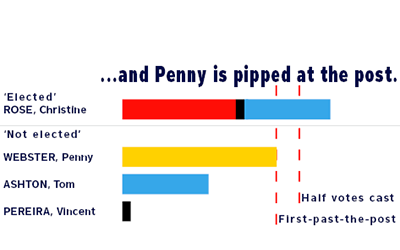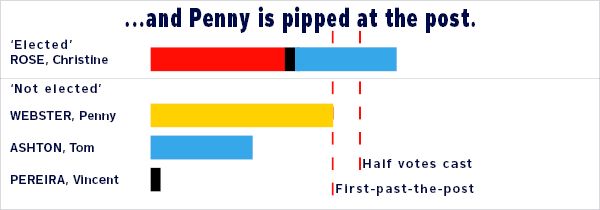Second past the post preferred


First-Past-the-Post Crudity: When the Rodney Ward elected its first representative onto the governing body of the new Auckland Council, the candidate probably most preferred was the first runner-up. In this preference-voting approximation, it is crudely assumed that the second preferences of the first candidate eliminated, given his apparent politics, would all have gone to Christine Rose. Similarly crudely, given that Tom Ashton was overtly opposing Penny Webster it is assumed that all his second preferences would also have gone to Penny’s principal opponent. chart Mahurangi Magazine
Another election and another clamour to scrap preferential voting.
New Zealanders are wondering why Wellington, for example, would choose a system that makes ’em wait days to hear who they’ve elected mayor.
And sifting through interminable lists of district health board candidates is not for the faint-hearted—heartily fuelling resistance to preferential voting. Most voters will have struggled to make a decent fist of electing health board members, and most will blame preferential voting—nearly 33 000 filing blank or informal ballots for the Waitematā board alone.
Informed supporters of Aotearoa’s preferential system (single transferable voting, STV) squirm and insist it is superior, which it is—in principle. Sadly, as applied to district health boards, it is mostly failing to achieve the goal of its implementation: To elect Māori. The intention was that electing, in the case of Waitematā, seven members in a single ward would make it more likely that minorities could muster the support to elect representatives. In the past, when board areas were broken up into numerous wards, the likelihood of an ethnic minority representative being elected in any one ward was low—unless that minority was concentrated geographically. Folk tended to vote for the local candidate they knew, or at least knew of.
Le Fevre, prior to this election, is a name that did not enjoy strong name recognition. That Dr James Le Fevre was elected is probably owed to the preferential system, and his ‘supplied candidate information’ standing out in the stupefying 32-person lineup. Certainly, it wasn’t until preferences had been distributed 41 times that the computer program declared him the last of the seven elected. Few who seek the detail of how many first, second, third, through to seven preferences Dr Le Fevre received will make head nor tail of it. Fortunately, it is about as necessary to understand the horrors of how as it is to comprehend quantum physics, in order to boil an egg. What voters can be absolutely assured of is the Dr Le Fevre was preferred by more people than was the person placed eighth. Voters can also be assured that he is not prone to populist positions such as supporting the administration of high doses of ascorbate willy-nilly, unlike Christine Rankin:
I will fight for vitamin c to be given as requested. The current situation is disgraceful!!!!!!!
Ms Rankin’s apparent distain for scientifically conducted trials, which Dr Le Fevre strongly supports, clearly didn’t hurt her. Certainly, her election was despite ranking well down the alphabet—not the result of donkey voting. Not being recently disgraced probably helped—as opposed to Andrew Williams, elected in none of the three contests he entered.
In Wellington, the complexity of preferential voting will take a hammering. But of the six councils using the system, it is the only one where the outcome is in doubt. But this is due to it being an extremely close race, and a recount is probably inevitable—a cruelly protracted process.
Kaipara is certainly not in doubt, with Neil Tiller winning a second term. It was a two-horse race, as was the previous election—the only times when first-past-the-post is superior to preferential voting. Kaipara, of course, is where many Rodney voters craved to be voting. Tom Ashton stood against Rodney’s last mayor, Penny Webster, to punish her for not supporting the futile bid to wed the northern part of the old Rodney District to Kaipara. Under preferential voting, such an action might have succeeded in hurting Mrs Webster’s prospects of representing the regional entity she has fought tooth and nail since its inception. Many of Mr Ashton’s supporter’s second preferences—and he polled a tidy preliminary 4170 votes—would have boosted Christine Rose’s 5889. This could have placed her, at least hypothetically, a good thousand votes ahead.
This, of course, is strictly hypothetical. There conceivably could have been some Ashton voters who were unaware of the Kaipara motive and simply liked the cut of the man’s jib. Besides, without the breakaway politics, it is probable that the Tamahunga ward would have been a two-horse race, which possibly would have been won by the candidate with saturation name and face recognition. The join-Kaipara lobby is unlikely to let up and will dog efforts by local representatives to make the new governance arrangements work. If the new mayor of Makaurau makes Rodney’s ex-mayor his deputy, as a unification measure, the separatists are likely to be particularly incensed.
The New Zealand Herald writer Bernard Orsman did offer Webster as deputy—to John Banks, a tad previously. The paper’s columnist Matt McCarten might have better suggestions. When recommending Sir John Walker for Manurewa–Papakura ward he said:
John Walker of course is a class act and he could run for any position he wanted and I’d back him. Maybe the Labour Party could beg him to lead their party at the next election.
In the event, Sir John received nearly 20 000 votes. That could help unite a region.
Footnote Matt McCarten said when recommending Christine Rose for the Tamahunga ward:
Rose is a sitting regional councillor and people I respect rate her highly as a hard-working competent moderate. That’s good enough for me.
